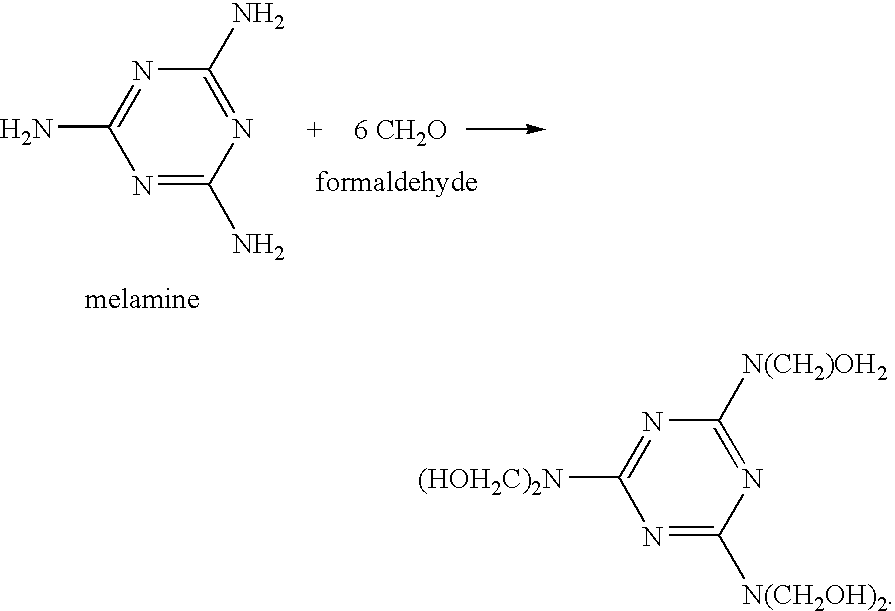Stable phenolic resin polymer dispersions having low free aldehyde content
a technology of phenolic resin and dispersions, which is applied in the field of aqueous dispersions of phenolic resin polymers, can solve the problems of interfering with later processing operations, etc., and achieves the effect of reducing the free aldehyde content and adversely affecting the chemical reactivity of the final resin end produ
- Summary
- Abstract
- Description
- Claims
- Application Information
AI Technical Summary
Benefits of technology
Problems solved by technology
Method used
Image
Examples
example 1
Melamine as an Aldehyde Scavenger (Reaction at 55° C. and 2.52 Equivalents)
[0058] The initial base-catalyzed reaction of formaldehyde and bisphenol-A, followed by dissolution of the phenolic resin reaction product in butyl CELLOSOLVE™, was performed as described above in Comparative Example 1. After cooling the phenolic resin solution to 55° C., it was sampled and the free formaldehyde content was found to be 1.80% by weight.
[0059] Melamine was then tested for its effectiveness as an aldehyde scavenger as well as its ability to form a stable dispersion of the phenolic resin. A quantity of melamine representing about 2.52 equivalents per mole of free formaldehyde (or about 0.42 moles per mole) was added to the phenolic resin solution. The alkaline solution was mixed for 30 minutes at 55° C. to allow the aldehyde scavenger to react at this temperature. After this reaction period, the free formaldehyde content was reduced to 0.69% by weight.
[0060] The solution was then acidified by...
example 2
Melamine as an Aldehyde Scavenger (Reaction at 75° C. and 4.41 Equivalents)
[0063] The initial base-catalyzed reaction of formaldehyde and bisphenol-A, followed by dissolution of the phenolic resin reaction product in butyl CELLOSOLVE™, was performed as described above in Comparative Example 1. After cooling the phenolic resin solution to 55° C., it was sampled and the free formaldehyde content was found to be 2.10% by weight.
[0064] A higher level of melamine addition, compared to that used in Example 1, was then tested for its effectiveness as an aldehyde scavenger as well as its ability to form a stable dispersion of the phenolic resin. A quantity of melamine representing about 4.41 equivalents per mole of free formaldehyde (or about 0.74 moles per mole) was added to the phenolic resin solution. The alkaline solution was then heated to 75° C. and mixed for 30 minutes to allow the aldehyde scavenger to react at this temperature. After this reaction period, the free formaldehyde c...
example 3
Melamine as an Aldehyde Scavenger (Reaction at 75° C. and 5.72 Equivalents)
[0069] The initial base-catalyzed reaction of formaldehyde and bisphenol-A, followed by dissolution of the phenolic resin reaction product in butyl CELLOSOLVE™, was performed as described above in Example 2. After cooling the phenolic resin solution to 55° C., it was sampled and the free formaldehyde content was found to be 1.62% by weight.
[0070] A slightly higher level of melamine addition, compared to that used in Example 2, was then tested for its effectiveness as an aldehyde scavenger as well as its ability to form a stable dispersion of the phenolic resin. A quantity of melamine representing about 5.72 equivalents per mole of free formaldehyde (or 0.95 moles per mole) was added to the phenolic resin solution. The alkaline solution was then heated to 75° C. and mixed for 30 minutes to allow the aldehyde scavenger to react at this temperature. After this reaction period, the free formaldehyde content wa...
PUM
| Property | Measurement | Unit |
|---|---|---|
| temperature | aaaaa | aaaaa |
| temperature | aaaaa | aaaaa |
| temperature | aaaaa | aaaaa |
Abstract
Description
Claims
Application Information
 Login to View More
Login to View More - R&D
- Intellectual Property
- Life Sciences
- Materials
- Tech Scout
- Unparalleled Data Quality
- Higher Quality Content
- 60% Fewer Hallucinations
Browse by: Latest US Patents, China's latest patents, Technical Efficacy Thesaurus, Application Domain, Technology Topic, Popular Technical Reports.
© 2025 PatSnap. All rights reserved.Legal|Privacy policy|Modern Slavery Act Transparency Statement|Sitemap|About US| Contact US: help@patsnap.com

